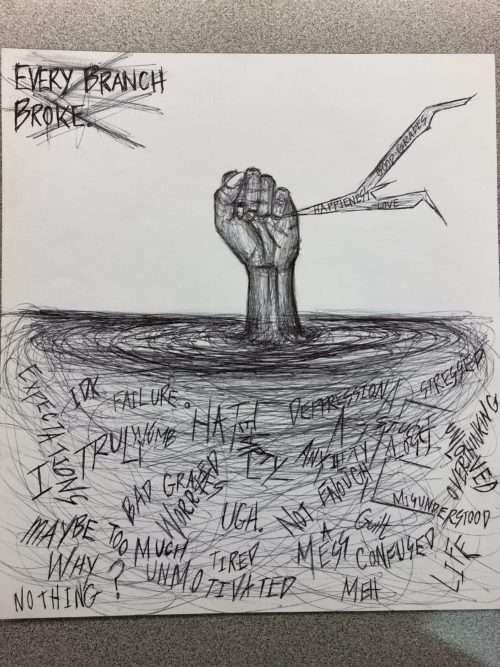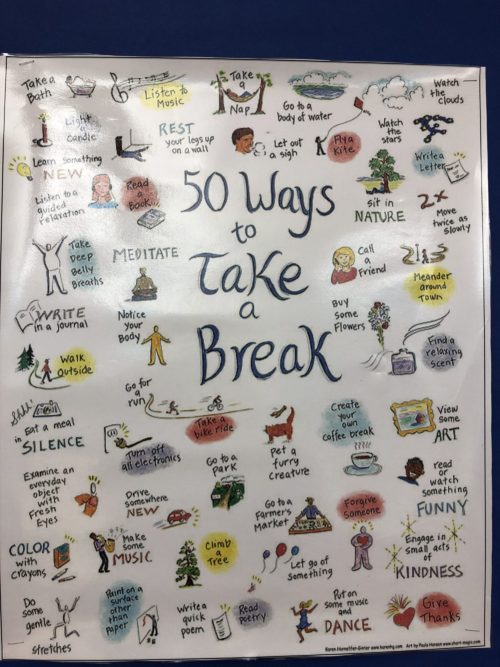Ava first began to experience anxiety and depression after her parents divorced, when she was still in grade school. These problems increased as she entered her teen years, and became even more severe in ninth grade, when she enrolled at Cambridge Rindge & Latin School, a vast campus with nearly 2,000 students. Faced with large, noisy classrooms, Ava froze with fear. By her sophomore year, she felt unable to cope. When her mother dropped her off one morning, Ava looked out at the school building, but couldn’t open the car door to go inside.
She began to miss two or three days of school a week. In April of that year, she stopped attending altogether.
“Some days I couldn’t even get out of bed,” said Ava, who is 17 with light auburn hair. “I’d find anything to hold on to physically, so I wouldn’t have to move.” (The last names of students featured in this story have been withheld to protect their privacy.)
Ava’s physician suggested she look into BRYT, or Bridge for Resilient Youth in Transition, which helps students return to school after extended mental health-related absences. Ava, now a junior, was skeptical at first. But eventually she agreed to transition back to school while spending one period a day in the program’s dedicated classroom, where she received emotional and psychological support and assistance catching up on the schoolwork she’d missed.
Ava was fortunate. As many as one in five children need help with a mental health condition such as anxiety or depression. These students often have trouble processing information or focusing, which can contribute to a cycle of increased anxiety, dropping grades and missed school, say experts. Yet schools typically lack the money and staff to help students cope with what experts describe as a mental health epidemic. One study found that nearly 80 percent of students failed to receive the mental health care they needed, and more than 50 percent of students ages 14 and older with emotional and behavioral disabilities drop out of school.
“Districts that are less resourced might be sharing one psychologist for the entire school district, or one psychologist who is responsible for 3,000 kids,” said Kelly Vaillancourt Strobach, policy director for the National Association of School Psychologists (NASP). “When you have these shortage of these professionals, you’re really only able to serve those kids who are in extreme crisis.”

Absent a national blueprint for helping students cope with mental health conditions, states are scrambling to identify potential prototypes. The BRYT program, which was founded and pioneered in a Boston-area school in 2004 by the nonprofit Brookline Center for Community Mental Health, has emerged as a successful model for helping kids re-enter school after a mental health crisis.* The Brookline Center works with school districts to help them plan and implement BRYT programs, which are staffed by school employees. Although the center doesn’t finance programs, it helps schools identify potential sources of funding.
Ninety percent of students in BRYT remain on track to graduate, and their attendance rates have increased from 52 percent before participation to above 80 percent after. The program itself is expanding. BRYT’s director, Paul Hyry-Dermith, said 137 schools in Massachusetts now employ the program and pilots are starting to roll out in Rhode Island, New York and New Hampshire. Partnerships are also in the works with school districts in Washington state and Oregon.
At Cambridge Rindge & Latin, an ethnically diverse school that in 2018 sent 82 percent of its graduates to college, the BRYT classroom is tucked at the end of a quiet hallway. Blue parchment covers the fluorescent ceiling lights, showering the space in a balmy azure. A walnut-stained rocking chair with an embroidered cushion that reads “Be Kind” rests in one corner. In another corner, a noise machine beckons for attention before it’s soon forgotten.
Eleven students spend one assigned period a day here, where they chat with counselors, prepare for and work on homework assignments with the program’s academic liaison, or simply rest and relax. Students are also welcome in the room any time they feel overwhelmed.
“Many of the kids in our program are coming out of a psychiatric hospitalization,” said Ashley Sitkin, BRYT clinician/program leader at Rindge & Latin. “Some of the kids haven’t been hospitalized but they’ve missed a lot of school because they’ve gotten stuck in this avoidance cycle, which is really common for kids who struggle with anxiety and depression.”
At Rindge & Latin, Sitkin and her colleague, academic coordinator Nkrumah Jones, disrupt that cycle with a three-to-four-month reintegration plan that includes emotional support and mental care coordination. That includes a clinical diagnosis of students before they enter the program, and constant contact with outside health providers who also provide each student with care. Sitkin and her staff also reach out to parents and keep them informed. Academic coordination is crucial, too. Both BRYT coordinators and teachers acknowledge it is unrealistic to expect students who miss weeks of school to make up all class work, so care coordinators serve as a liaison between student and teacher, indentifying key assignments and ironing out a make-up plan.
Eli, a trans student at Rindge & Latin, began to battle with depression in eighth grade, a condition that worsened the following year when he entered high school. By his sophomore year, therapy and medication proved fruitless. Eli stopped going to school. He checked into a psychiatric hospital, an experience that his mother said replenished Eli’s hope and helped him kick his meds. But the thought of returning to school tormented Eli. Unable to walk into the building, he met Sitkin and Jones at the school door before being escorted to the safe space.
“I was dealing with pretty severe anxiety and depression. I would miss school, which would make me more stressed, which meant I would want to miss more school,” said Eli. Before participating in BRYT, Eli, now a senior, would attend just three or four classes a day, he said. Gradually, with help from Sitkin, he returned to classes full time. “I was behind on school work before I left, so the academic coordination, having someone else deal with my teachers, was really, really helpful.”
At Rindge & Latin, the mental health challenges students contend with have become more severe in recent years. Student suicide is a growing worry. Several students attempted suicide this semester, teachers and staff said. “I had a student today tell me she’s feeling very suicidal,” said Sitkin.
That’s part of a national trend. The suicide rate for children and young adults, ages 10 to 24, rose by 56 percent from 2007 and 2017 and is now the second leading cause of death among teenagers, according to the Department of Health and Human Services. Some 3,000 high school students across the U.S. attempt suicide every day.
Duncan MacLaury, a history teacher in his fourth year at Rindge & Latin, said he often sees students struggling with depression and suicidal ideation. Ibrahim Dagher, who teaches Arabic at the school, also sees the symptoms, though often they are hard to detect.
“I have a student who has been through a very traumatic experience,” said Dagher. “She attempted suicide this year, and I had no idea, meaning I saw no signs. She was present in class the day of, so that really shocked me.”

Experts point to the increased use of smart phones and social media as the likely culprit for the spike in teen suicide over the last decade. New technology keeps kids in front of screens instead of interacting face-to-face with their peers, they say, which leads to increased isolation. It can also expose them to feelings of insecurity and to cyber harassment and bullying.
Social media helped exacerbate emotional problems for Tashin, 17, a junior at Rindge & Latin. She first started experiencing anxiety after exposure to family violence, but her slide into depression hastened when she was in eighth grade, after students began to bully her online. They would create group chats on Instagram mocking her and then send posts her way. The social bullying continued when Tashin was a sophomore at Rindge & Latin, and she began to miss school. Shortly afterward, she entered a hospital after she began to cut herself.
“That has stayed with me,” said Tashin, now a junior and a BRYT alum, of the social media bullying. “A lot of people told me I wouldn’t get anywhere in life.”
Dorchester, just south of Boston, wallows in hardship. The per capita income is just $26,292, the second lowest in the Boston area, and almost more than $10,000 less than the city average. Just 14 percent of residents hold bachelor’s degrees. The 460 students at Boston Arts Academy reflect these economic burdens: Two thirds come from economically disadvantaged families, and one third entered ninth grade reading below grade level.
Students at the Academy, the Boston school system’s only public high school for the arts, carry the weight of stress and community violence, said Charmain Jackman, the school’s dean of Health & Wellness. Students embody these stressors with increased levels of depression and trauma. Thought disorders like schizophrenia and delusional disorder are also up here, all made worse, said Jackman, by the recent death of a beloved teacher.
That has placed pressure on the school’s mental health services, and its Bridge program, which is similar to the BRYT model used at Rindge & Latin. Besides helping students reenter school after mental health-related absences, the program, started in 2014, focuses on what directors call pre-emptive help. If program coordinators notice a student becoming high risk — excessive absences or tardiness —they will intervene.
The dedicated classroom here is tiny, a roughly 12- by 15-foot room crammed with a few 5-foot-long desks and two computers. A tack board welcomes the program’s nine participants and helps coordinators keep track of student comings and goings.
Despite its narrow confines, the room served as a home for Dashawn, a senior here, at a time he desperately needed shelter. As a sophomore, Dashawn lost his father. Devastated family members went their separate ways. Dashawn’s mother slid into depression, exacerbated by her inability to afford the rent after her husband’s death; she moved to Georgia to start a new life. Penniless and alone, Dashawn drifted from friend’s house to friend’s house. Inevitably, he was asked to leave after a few weeks. He slept in hallways at times.
“Outside it’s like, ‘Damn, where am I going to sleep tonight?’” said Dashawn, now 19. “Coming to school is the part where, ‘OK, you’re good for now.’”
Dashawn credits Bridge with giving him a space where he could be vulnerable and let his emotions out. Sarah Nichols, coordinator of the Bridge program, and Jackman helped just by being there and reassuring him he could get through a rough patch in his life, he said. The program also helped him communicate with his teachers and make up assignments. Program coordinators gave him gift cards for food and helped him fill out applications for housing. But they also gave him a space to sit down and gather his thoughts.
“I’ve had tensions with teachers because they think, ‘Oh, you’re not working, your quality is not good enough,’” said Dashawn, who now lives with an uncle in a stable setting.
“It’s hard to meet these expectations when you’re going through a lot outside of school,” he said, crediting Bridge with helping him sprout into adulthood. “I’m starting to walk now, and I’m just thankful.”
Boston Arts Academy does not have the resources that Rindge & Latin enjoys. Students shuffle through dim corridors. The school’s makeshift library spills from one dedicated classroom into an adjacent hallway. Substance abuse is up among students, 90 percent of whom are people of color, mostly Latino and black. Jackman, who said her mornings are filled with “back-to-back” students, described the Academy as an urban school with a lot of stress and few resources.
“Every school personnel I’ve spoken to have talked about increased stress and anxiety of students in general,” said Jackman. “It’s relentless right now.”
But staff at both schools said one of their biggest frustrations is that, although anxiety is widespread, they only have time for the students with the most acute problems.
“Early intervention is much more effective than waiting until a kid is in a crisis, and that’s what happens in a lot of schools that don’t have these adequate members of mental health staff,” said Vaillancourt Strobach of the National Association of School Psychologists. “There is an entire population of students who really aren’t getting the care that they need, or it’s putting the responsibility on the community, where there is also a significant shortage.”
Sitkin at Rindge & Latin emphasized that BRYT is a short-term stabilization model. She agrees with Vaillancourt Strobach — schools need to be better equipped to help students cope with social-emotional issues when they’re younger, before the problems grow. Only focusing on students in crisis is unsustainable, she said.
Sitkin, referring to herself, said, “Ten Ashleys can help 100 more students, but it’s not going to solve the problem. But how do we help the majority of students who also have struggles? There is always going to be those students.”
But for struggling students like Ava at Rindge & Latin, the help they receive at school can alter the course of their lives.
“BRYT is a miracle worker in a way. I wasn’t going to finish high school,” said Ava. “It’s about getting out of the car. It’s about being here and being OK.”
*Correction: This sentence has been updated to correct the name of the Brookline Center for Community Mental Health and the number of schools in which it was started.
This story about mental health in schools was produced by The Hechinger Report, a nonprofit, independent news organization focused on inequality and innovation in education. Sign up for the Hechinger newsletter.
If you or someone you know may be considering suicide, contact the National Suicide Prevention Lifeline at 1-800-273-8255 (En Español: 1-888-628-9454; Deaf and Hard of Hearing: 1-800-799-4889) or the Crisis Text Line by texting HOME to 741741.
